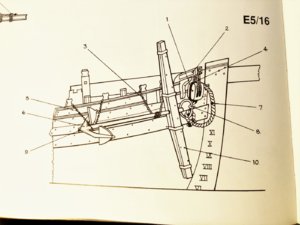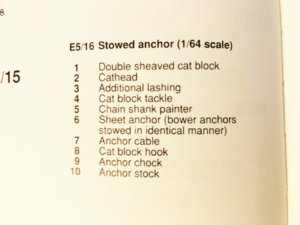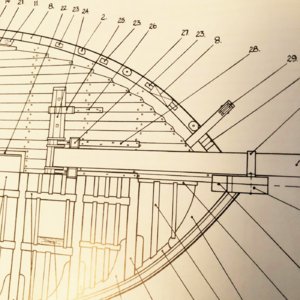-

Win a Free Custom Engraved Brass Coin!!!
As a way to introduce our brass coins to the community, we will raffle off a free coin during the month of August. Follow link ABOVE for instructions for entering.
You are using an out of date browser. It may not display this or other websites correctly.
You should upgrade or use an alternative browser.
You should upgrade or use an alternative browser.
Take a look here.......I think the rope through the cathead was fixed at one belaying point.
Here you can find a diagram / sketch

 suburbanshipmodeler.com
suburbanshipmodeler.com
For which type of ship and period you are looking for?
Maybe I can find more in my library
Here you can find a diagram / sketch

Anchors
Day 373. I’m nearing the end of the work on the deck. All that remains are the anchors and the dories. The Bluenose carries two anchors. Typically, when the ship isn’t racing, it has …
 suburbanshipmodeler.com
suburbanshipmodeler.com
For which type of ship and period you are looking for?
Maybe I can find more in my library
- Joined
- Mar 2, 2012
- Messages
- 112
- Points
- 103

Thanks! It’s for my Lady Nelson. It’s not a real ship, but a typical British Navy cutter.Take a look here.......I think the rope through the cathead was fixed at one belaying point.
Here you can find a diagram / sketch

Anchors
Day 373. I’m nearing the end of the work on the deck. All that remains are the anchors and the dories. The Bluenose carries two anchors. Typically, when the ship isn’t racing, it has …suburbanshipmodeler.com
For which type of ship and period you are looking for?
Maybe I can find more in my library
The rope via the cathead was only a relatively short time under use, only after the anchor was lifted (anchor was lifted via the anchor cable over the windlass...) until the anchor was slashed against the hull. so it was only to secure the anchor in this phase.Thanks! It’s for my Lady Nelson. It’s not a real ship, but a typical British Navy cutter.
I looked at the Anatomy book of the Cutter Alert - also here it is not visible where the rope was fixed, but I guess at one of the or belaying points or the pawl bitt pin



I am going to make a suggest that is frustrating to many modelers who strive for accuracy. It doesn't matter. Let me explain. Think of the function of the cathead and the rigging needed to accomplish that function. Where one exactly belays a line only matters to accomplish the function. So, keeping leverage in mind...belay the rigging to the nearest functional point even if that means you need to add a ring bolt or sheave. Yes, you can use diagrams of how actual ships accomplished the functions but when one thinks about it all, they simply rigged out the cathead to accomplish the function in the most efficient way possible. Sometimes thinking differently helps reduce the anxiety about doing it "exactly right!"
- Joined
- Mar 2, 2012
- Messages
- 112
- Points
- 103

Wasn’t trying to make it complicated and my question isn’t about the belay point but how it runs through the sheaves and where the two ends terminate.I am going to make a suggest that is frustrating to many modelers who strive for accuracy. It doesn't matter. Let me explain. Think of the function of the cathead and the rigging needed to accomplish that function. Where one exactly belays a line only matters to accomplish the function. So, keeping leverage in mind...belay the rigging to the nearest functional point even if that means you need to add a ring bolt or sheave. Yes, you can use diagrams of how actual ships accomplished the functions but when one thinks about it all, they simply rigged out the cathead to accomplish the function in the most efficient way possible. Sometimes thinking differently helps reduce the anxiety about doing it "exactly right!"
Obviously one end goes to a belay point, but does both. My question is practical not one of historical accuracy. I think I worded it as such, but thanks for the lecture.
Sorry...my apologies. Typically one termination point is belayed to a block with a hook. Hook on one end...the rigging rope on the other. Thus the rope goes from the block up through a sheave on the cathead...down through the block hooked to the anchor ring...back through the second sheave...and if only two sheaves on the cathead the rope terminates on the bulkhead. If three sheaves then back down through a double block...back up through the third sheave and then terminated on the bulkhead at some point. My apologies again...did not mean to lecture...Wasn’t trying to make it complicated and my question isn’t about the belay point but how it runs through the sheaves and where the two ends terminate.
Obviously one end goes to a belay point, but does both. My question is practical not one of historical accuracy. I think I worded it as such, but thanks for the lecture.
Last edited:
Also the ships were rigged differently from captain to captain. The captain of the ship had the say as to how he wanted it riggedI am going to make a suggest that is frustrating to many modelers who strive for accuracy. It doesn't matter. Let me explain. Think of the function of the cathead and the rigging needed to accomplish that function. Where one exactly belays a line only matters to accomplish the function. So, keeping leverage in mind...belay the rigging to the nearest functional point even if that means you need to add a ring bolt or sheave. Yes, you can use diagrams of how actual ships accomplished the functions but when one thinks about it all, they simply rigged out the cathead to accomplish the function in the most efficient way possible. Sometimes thinking differently helps reduce the anxiety about doing it "exactly right!"



